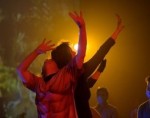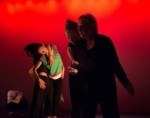
Photo: La Dolce Photography
Lynching and Love
By Megan Bridge
This correspondence between writer Megan Bridge and Lela Aisha Jones, creator of
Street Grace Series: Native Portals of Lynching and Love, is interwoven with Bridge’s responses to a performance of the work in the First Person Arts Festival on November 15.
Megan Bridge: What have the challenges or easy parts been with your rehearsal process? Is it an emotional process?
Lela Aisha Jones: The physicality of embodying a memory does things to you that I am not sure have words. Touching a noose. Putting it around you. Moving with an image of a hanging body in mind. A dead body that someone decided should die... Not sure I am ready to write on this.
--------------------------------
There are several nooses hanging from the ceiling. The theater darkens, lights focus on one. A dancer nudges the noose with her nose, her cheekbone, her forehead. “Please stand for the Negro National Anthem...” Lela’s beautiful voice rings out in the theater. Other voices around me join in hesitantly. Maybe two or three actually know all the words. This melody seems much more complicated and difficult than the National Anthem that I know. But that’s just it. What’s unfamiliar often intimidates when one first confronts it.
--------------------------------
MB: What is your relationship as a choreographer to abstraction and narrative? How are you working with structure?
LAJ: I work and play in between-ish. Life is not linear. My work is cyclical and linear. Memories are some of our own manifestations. My work is open to varying manifestations. I love historical fiction and downright recorded fact. Stories elaborate and offer context. I want the story(ies) to make folks feel something they know is alive while also waking up stuff that may be dormant. I am trying to offer experiences and a transference of information from the literal story to the bodily response. How does the body understand the trauma of lynching and loving the U.S.?
--------------------------------
Six women. Each tells a story, danced and spoken, of her first contact with the imagery of lynching. The voice-over monologues speak of being swallowed up by fear, feeling devalued and trapped. One dancer mimes devouring the noose. Their movement makes reference to lassos...or whips? Holding the end of a length of rope, the dancers accumulate in a circular pattern, some sort of twisted Maypole dance, singing “eenie meenie miney moe, catch a tiger [then later 'nigger'] by his toe....”
--------------------------------
MB: How do you contextualize your work within the rhetoric of multiculturalism?
LAJ: Multiculturalism is just not real to me...yet. I want another word but I don't think it has been invented yet. It would take respect, not just tolerance, to attain what I think multiculturalism is reaching for, and my experience has been that we [have settled for] tolerance and the exotic...Many folks are saying what I am about to say, which is how will a place (the U.S.) of so many multiplicities get beyond tolerance? Who has time, right? How will we invest in one another and people who are different from us? People whose ancestors may have hurt each other's ancestors? Slavery... These are heavy conversations. And more need to be had. Like, why does Columbus Boulevard exist? Seriously? Without just enjoying the romantic and beautiful aspects, can we engage with the pain of one another?
--------------------------------
Lela moves through the work as a maternal figure, often observing, or observed by, the other dancers from a distance. She attends to the set, hanging up a boot, a hat, a child’s chair. I think of my sweet five-year-old boy, sleeping at home. Confronting the images, the pain that these beautiful women speak of would crush his innocence. But public lynchings were celebrations, children were brought to these orgies of violence. Broken necks and suffocation. Celebrations.
--------------------------------
MB: What is your, or your work’s, relationship to the term “black dance?”
LAJ: It is clear when I stand in front of you that I have brown skin. Which kinda makes me a black woman, but I am so much else, more...Representation is still relevant today, so I am still living in a land of color, dreaming of more community acknowledgement of how color, in conjunction with class and again so much else, is so intricately and invisibly woven into how we live. My work (this work) is coming from my perspective, which is an experience of living black. So it has to be black dance, right? It is just that black is not all I am saying in my dance...I come from many versions of blackness...I live in states of blackness...emerging is a diasporic movement practice, life practice, that is informed by my passing interactions with many, and my intricate detailed attention to the memories, stories, and movements of people who were dispersed through forced migrations, or the descendants or generations past those initial experiences.
--------------------------------
The movement is more confrontational now. A recorded voice reads “What if I did get mad, what if I don’t go with the flow? ‘People are trapped in history, and history is trapped in them’ (James Baldwin).” I see big, huge, spiraling rolls in the dancers’ heads, necks, torsos. The movement is all at once from so many places: the African diaspora, contemporary dance, vernacular culture, hip hop. Their torsos are as articulate as fingers. A spiral is initiated in the arms and taken up by the ribcage, pelvis, and head simultaneously. Ripples of movement flow in near unison, which allows for individuality of interpretation across the group.
--------------------------------
MB: Can you talk a bit about your interest in or commitment to carving out a space for artistic expression of women of color in Philadelphia or the dance community at large? What about men of color? What about white women (clearly a majority in dance but as women still “othered” in certain spheres like the capitalist economy, politics, discursive struggle around ownership of the body, etc.)?
LAJ: It seems relevant here to talk about depth of access as well as lifestyle or cultural requirements/responsibilities/demands. I find that many women of color, black women, or women of African descent, have multiple responsibilities that don't always allow for a complete focus on a career as an artist. They desire the time to develop and research their art but are constantly reconciling cultural, economic, and social responsibilities. All of our choices have costs and benefits for sure. There is a part of me that feels being an artist is selfish. My family needs things. My community needs things and there is a little voice inside me that says “buy someone a book or a meal instead of that costume for your artistic work.” The women I am in contact with are asking, or I am seeing them negotiate with, questions relevant to many, like “will I be able to take care of myself financially or emotionally and where is the time to develop my work? Who can really give me feedback on my work from where I am coming from? Who will fund that and why? What is valued as worth investing in?” Many artists are asking these questions, some from a place of greater marginalization than others, and that is informed by many factors. Some are relegated deeper into the peripheries than others. I would say I find in my experiences that black women are a part of the "some" deeply embedded in the peripheries.
--------------------------------
The post-show Q & A opens with a call-out. The audience’s first responses: “Celebration. Bearing witness. Transparency. Shadows. Remembering. Masterfully integrating narrative and movement. Gaze. Ghosts. Hoodies. Nooses dropping. Acceptance. Pain. Repetition. Awesome.” Yes.
--------------------------------
*This is recognized as a pejorative and politically loaded term used to demean black people. While certain publications may censor its appearance in print, thINKingDANCE has allowed it to appear here as a direct quotation from text within the artist’s work.
Street Grace Series: Native Portals of Lynching and Love, First Person Arts Festival, Christ Church Neighborhood House, Nov. 15-16, 2012.
By Megan Bridge
November 21, 2012







.png)


